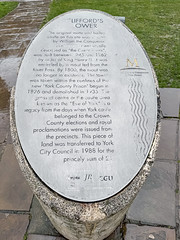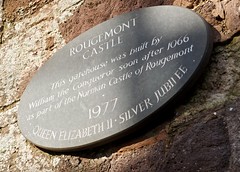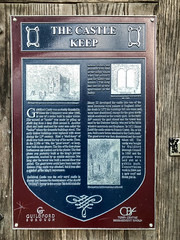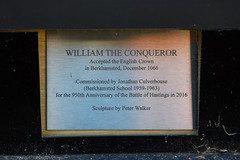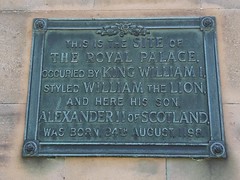

King William I of England
(1028-1087)
Duke of Normandy (1035-1087) and King of England (1066-1087)
Died aged c. 59
Wikidata WikipediaWilliam I (c. 1028 – 9 September 1087), usually known as William the Conqueror and sometimes William the Bastard, was the first Norman king of England, reigning from 1066 until his death in 1087. A descendant of Rollo, he was Duke of Normandy from 1035 onward. By 1060, following a long struggle to establish his throne, his hold on Normandy was secure. In 1066, following the death of Edward the Confessor, William invaded England, leading an army of Normans to victory over the Anglo-Saxon forces of Harold Godwinson at the Battle of Hastings, and suppressed subsequent English revolts in what has become known as the Norman Conquest. The rest of his life was marked by struggles to consolidate his hold over England and his continental lands, and by difficulties with his eldest son, Robert Curthose. William was the son of the unmarried Duke Robert I of Normandy and his mistress Herleva. His illegitimate status and his youth caused some difficulties for him after he succeeded his father, as did the anarchy which plagued the first years of his rule. During his childhood and adolescence, members of the Norman aristocracy battled each other, both for control of the child duke, and for their own ends. In 1047, William was able to quash a rebellion and begin to establish his authority over the duchy, a process that was not complete until about 1060. His marriage in the 1050s to Matilda of Flanders provided him with a powerful ally in the neighbouring county of Flanders. By the time of his marriage, William was able to arrange the appointment of his supporters as bishops and abbots in the Norman church. His consolidation of power allowed him to expand his horizons, and he secured control of the neighbouring county of Maine by 1062. In the 1050s and early 1060s, William became a contender for the throne of England held by the childless Edward the Confessor, his first cousin once removed. There were other potential claimants, including the powerful English earl Harold Godwinson, whom Edward named as king on his deathbed in January 1066. Arguing that Edward had previously promised the throne to him and that Harold had sworn to support his claim, William built a large fleet and invaded England in September 1066. He decisively defeated and killed Harold at the Battle of Hastings on 14 October 1066. After further military efforts, William was crowned king on Christmas Day, 1066, in London. He made arrangements for the governance of England in early 1067 before returning to Normandy. Several unsuccessful rebellions followed, but William's hold was mostly secure on England by 1075, allowing him to spend the greater part of his reign in continental Europe. William's final years were marked by difficulties in his continental domains, troubles with his son, Robert, and threatened invasions of England by the Danes. In 1086, he ordered the compilation of the Domesday Book, a survey listing all the land-holdings in England along with their pre-Conquest and current holders. He died in September 1087 while leading a campaign in northern France, and was buried in Caen. His reign in England was marked by the construction of castles, settling a new Norman nobility on the land, and change in the composition of the English clergy. He did not try to integrate his various domains into one empire but continued to administer each part separately. His lands were divided after his death: Normandy went to Robert, and England went to his second surviving son, William Rufus.
DbPedia
Family tree
Commemorated on 9 plaques
Tradition says that William the Conqueror landed at Bulverhythe and dined on this stone
Opposite Royal Victoria Hotel, Marina, St Leonards, Hastings, United Kingdom where they landed and dined
Clifford's Tower. The original motte and bailey castle on this site was erected by William the Conqueror. The present tower usually described as "the Great Tower", was built between 1245 and 1262 by order of King Henry III. It was encircled by a moat fed from the River Foss. By 1800, the moat was no longer in existence. The tower was taken within the confines of the new 'York County Prison' begun in 1826 and demolished in 1935. The grassed centre of the castle area known as the "Eye of York" is a legacy from the days when York castle belonged to the Crown. County elections and royal proclamations were issued from the precincts. This piece of land was transferred to York City Council in 1988 for the princely sum of £1.
Tower Street, York, United Kingdom where they erected the original motte and bailey castle on this site
Rougemont Castle. This gatehouse was built by William the Conqueror soon after 1066 as part of the Norman castle of Rougemont
Castle Street, Exeter, United Kingdom where they built
The Long Brooke crossed this road some seventy feet sovth-west. The wooden footbridge which spanned it, was removed when the river was arched over A.D 1832. William the Conqveror and his troops, waded its water intent vpon besieging ovr city. A.D. 1069. Harry Hems
86 Longbrook Street, Exeter, United Kingdom where they was
Abernethy Round Tower. This tower and the similar tower at Brechin, in Angus are the only two round towers of the Irish Celtic type in Scotland. Here the Romanesque windows of the befry suggest that the tower was built in the later 11th Century. Long before this Abernethy was important as a principal seat of a Celtic Bishopric. Malcome Canmore and William the Conqueror met at Abernethy in 1072 possibly here.
, Abernethy, United Kingdom where they was (1072)
Guildford Castle was probably founded by William the conqueror soon after 1066, as one of a series built in major towns. The mound or ‘motte’ was made by pulling up chalk dug from a deep ditch around it. Another ditch and bank enclosed the outer area called the “bailey” where the domestic building stood. The early timber buildings were replaced with stone during the 12th century. First a ‘shell-like’ of chalk was built around the top of the motte. Then, in the 1130s or 40s, the ‘great tower’, or keep, was built in two phases. The line of the first-phase battlements are marked out in plaster. The first phase was probably built as the king's private apartments, reached by an outside staircase. Not long after the tower was built a second floor was added. The great tower could have been used for defence if the castle was attacked, but it was also a symbol of the kings importance. Guildford Castle was the only royal castle Surrey and became the headquarters of the sheriff the king’s deputy in the county. He held trials for serious crimes, and prisoners were held the keep, which was the county gaol for Surrey and Sussex. The king had moved to new apartments the bailey. Henry III developed the castle into one of the most luxurious role palaces. in England. After his death in 1272 buildings fell into ruins and were later abandoned, except for the great tower which continued as the county gaol. In the early 16th century the gaol closed and the tower was used by the Daborne family, who put in the brick window surrounds and fireplaces. In 1611 James I sold the castle estate to Francis Carter. He, or his son, built a new house attached to the Castle Arch. The great tower was then abandoned and then roof taken off. The castle was bought by Guildford Borough Council 1885 and the grounds were laid out as a public park. Conservation work in 2004 saw a new roof and floors put in.
Castle Street, Guildford, United Kingdom where they was
William the Conqueror Accepted the English Crown in Berkhamsted, December 1066
Castle Street, Berkhamsted, United Kingdom where they was crowned King (1066)
This is the site of the royal palace, occupied by King William I, styled William the Lion, and here his son Alexander II of Scotland, was born, 24th August, 1198.
Court Street, Haddington, United Kingdom where they occupied
Bramber A Ruined Norman Castle The ruined remains you can see above the village are of a castle built by the powerful de Braose family, who were lords of the Rape of Bramber for over 300 years from about 1080. Bramber Rape was a wide belt of land extending from the coast at Shoreham as far as the Surrey border near Crawley. The castle was built by William de Braose on part of a huge earlier Anglo-Saxon estate centred on Washington (to the west, beside the A24) which was given by William the Conqueror to him and his family. At that time the Adur was fully navigable to this point, and there was a port below the castle. The third William de Braose was favoured by King John, but they fell out, and his wife and heir were imprisoned in a dungeon at Windsor and starved to death. William escaped, disguised as a beggar, and fled to France. The castle was allowed to decay into ruins after the last de Braose who owned Bramber died in 1394, he is buried in Horsham church. Just down the street is St Mary's, the timber-framed remains of an inn built by the bridge in the mid-1400s, close to the port that once existed at Bramber. Both the Castle and St Mary's are open to the public.
The Street, Bramber, Steyning, United Kingdom where they was

